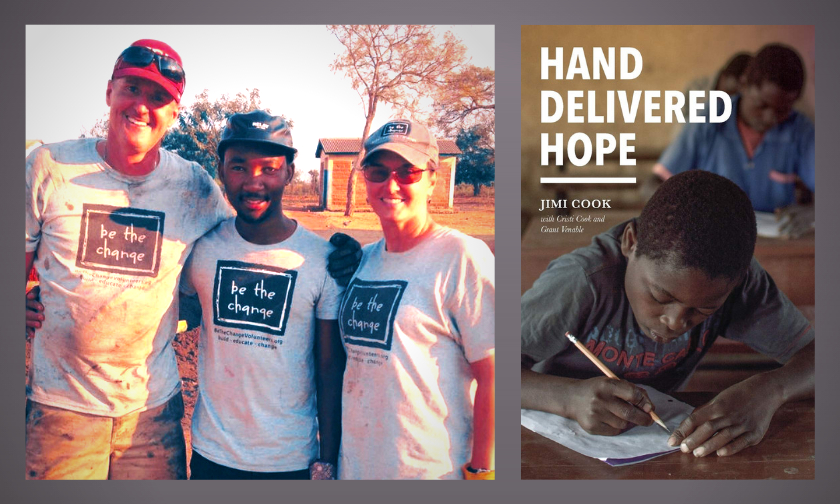
Jimi Cook is a Columbia, MO author who recently came out with his debut book, “Hand Delivered Hope.” The book is the story of how Jimi and his wife Cristi (both professors in orthopaedics at Mizzou) developed Be The Change Volunteers (BTCV), a nonprofit aid organization that builds schools and provides educational resources to forgotten communities around the world. Stories in the book include restoring a genocide ruined Rwandan school for a lost generation of learners, building a floating school on a huge lake in Cambodia, navigating corruption in Kenya, rebuilding relationships in India and many other engaging accounts of resilience and hope. I emailed some interview questions to him, and he was kind enough to take time to write back some answers.
Daniel Boone Regional Library: What’s the biggest challenge you’ve faced in delivering education related aid to the developing-world?
Jimi Cook: There are certainly a number of major challenges in striving to do education-focused development aid well, including fundraising, communication with partners in the developing world, long and difficult travel, complicated logistics, rough lodging and working conditions, and scary situations to navigate. But, I think for me, the biggest challenges are managing the expectations of volunteers and helping them deal with what we call “re-entry.”
Most of our first-time volunteers, who we call “Changers,” come to a project with many expectations regarding travel, the work, interactions with the team and community, and what they will be able to do for or give to others. Most of these expectations are shattered on day one of the project and so we have to work through this with each one individually, which is definitely a big challenge. But, it is also an incredibly beautiful thing to see the perspective-shifting and life-changing realizations that occur during this process that impact them forever.
Similarly, coming back home to their “first world lives” can be very confusing, unsettling and difficult. This re-entry phenomenon is such a common and major occurrence that we now have a whole packet of materials that we send to each volunteer after each project to help them navigate it well and turn it into a productive process that changes their lives for the better.
DBRL: The book is a well rounded mix of many genres (memoir, inspirational, management, travel, etc.). What was the main focus of the book when it was started? Did this change as you got further in your writing?
Cook: Thanks so much, it was definitely a true labor of love and I think the mix of genres is probably related to the nature of the work and the people, communities, and stories that the book draws from. Very insightful question too, as it definitely changed a lot during the course of writing.
It actually started as just a travel journal and notes that I made to myself so that I could remember and apply the incredible things that I was experiencing and learning to the organization and to my life. Then, as I told the stories to friends and families and started giving presentations about BTCV, people started telling me that I had to write a book. So, when I decided to take their advice, I started with what I was familiar with — scientific writing, which is a large part of what I do for a living — but that made the book come across as a “just-the-facts documentary” and it really did not have any “life” to it. So, I actually just put it away for about four years and went back to journaling and story-telling again.
After we lost our adopted son, Phomotso, writing became very cathartic and healing for me, and with the help of some friends, family, and a “writing coach,” I was able to find my story-telling voice in written form too. Then, the book just flowed and we were able to finish it up in less than a year.
DBRL: In the book you mention that you are a goal oriented person, and that you’ve even set a Big Hairy Audacious Goal (BHAG) of creating 100 education-focused aid projects during your lifetime. (You’re actually over halfway there at this point!) How has goal setting helped you & your organization? Would you recommend others have a BHAG?
Cook: Yes! I recommend that everyone has a BHAG that motivates them, inspires them, and drives them to make the world a little better every day. In fact, I start almost all my talks (for orthopaedic surgery or BTCV) with that question to the audience, “What is your BHAG?”
For me and the organization, it is a defining goal that keeps us focused on the mission, gets us through the tough and discouraging times, gives us an elevator speech that is clear and inspiring, and keeps us humble. We may not reach our ultimate goal, but the BHAG makes the effort and the journey towards it fun, powerful, and worth it!
DBRL: Read anything good lately you’d like to recommend?
Cook: From what I have read most recently, I would recommend “The Go-Giver” by Bob Burg and “The Shack” by William Young.
DBRL: Where can readers get a copy of your book?
Cook: Amazon, Barnes and Noble, Trilogy Christian Publishing, locally at Plume, or wherever books are sold.



